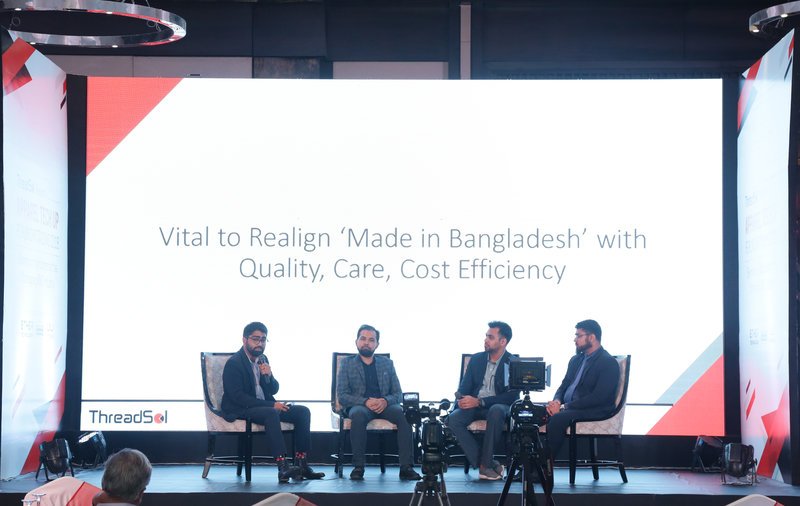Digitization of the Apparel Industry
The RMG industry in Bangladesh is celebrated as the leading (and dominating) source of export earnings for Bangladesh. Our position in the global market as the second-largest manufacturer of garments in the world is an accolade that we wear proudly, and the industry has been of immense support to the economic development of the country.
However, in the competitive era of globalization, the question is whether or not we can sustain this position and adapt to the changing trends. To address this concern, ThreadSol hosted the second edition of Apparel Tech Up for the Chittagong Apparel Industry in partnership with WebAble Digital, Ether Technology & The Center for Digital Transformation on 4th March 2018 at Radisson Blu – Bay View, Chittagong. The event was aimed to discuss different technology interventions for the Chittagong RMG Industry with the primary focus being the re-branding of Bangladesh RMG Industry and digitization for Bangladesh RMG Industry to meet the global sourcing requirements.
About Fast Fashion
Fast fashion is a practice within the fashion industry, which is used to identify trends in fashion. The concept is to try out some collection of clothing that is produced at a limited amount and an affordable price. Later the collections with the best response are reproduced and restocked in the stores. This practice is used in large retailers such as H&M, Zara, Peacocks, Primark, Xcel Brands, Topshop, etc.
The concept of Fast Fashion follows 3 simple steps Trend Injection, Read & React, and In-Season Chase.
Trend injection is a reactive approach to competition’s product range in a season.
Read & React: Small SKUs to do dipstick test for market response
In-Season Change: Revise manufacturing POs to focus on Fast Selling SKUs
Brands in this modern-day market stay on the lookout for, super vendors who have smaller lead times, shorter order runs, more styles, and produce high fashion, than the traditional vendors who produce basic fashion, have longer lead times, have larger order runs, and lesser number of styles.
Brands want to shift completely to a faster model to assist the practice of Fast Fashion. To keep competing in this highly competitive sector and hold their position, the manufacturers in Bangladesh need to start embracing digital transformation and transform themselves into Super vendors.
To achieve this, vendors need to:
1. Reduce Lead Times: Vendors need to plan quickly. An average order planning time with manual systems is 35-40 mins. Average order planning time with an automated system takes up to 7 mins giving vendors an 80% time reduction in order planning. With this improvement, if a factory produces 10 styles/day the lead time will be reduced by 5 hours in a day, 125 hours in a month, and over 1500 hours in a year. With the amount of saved time, more styles of clothing can be planned in a year with existing manpower. With order quantity shrinking per style and the number of styles increasing, the vendors can ensure that their costs don’t suffer.
2. Cost Better: 76% of Sourcing Directors chose lower material costs over lower labor costs as their preference for sourcing. Yet, fabric for 93% of orders is bought at incorrect consumption which results in short shipment and deadstock. These issues can be solved with the help of Artificial Intelligence, Big Data, and Mobility.
To survive, vendors need to reduce lead time so that they can handle more style changes, cater to in-season changes & reduce the cost to bid for more orders. Thus, the industry is ripe to be disrupted by digital transformation.
What is Digital Transformation?
Digital transformation is the change associated with the application of digital technology in all aspects of human society. The transformation stage means that digital usages inherently enable new types of innovation and creativity in a particular domain, rather than simply enhancing and supporting traditional methods.
How it relates to the Apparel Industry – global perspective?
Brands need to be able to predict the trend and be ready to respond to issues of uncertainty, risk, and reputation at all times. Some factors that are contributing to these issues are:
Evolving Regulations – Factory regulations are always evolving keeping the workers’ welfare in mind and many of these evolving regulations can be achieved with the help of technology. For example: ‘Workers can be given free health advice with apps like Maya Apa’. These apps work on smartphones as well as featured phones.
‘Faster Risks’ – Trend Forecasting – Trend and Fashion in the apparel industry change very fast and companies must be able to predict these changes and act fast. The upward trend in some of the cost components such as energy cost, interest rates, process losses, and leakages.
Broader Geographies – Competition in the RMG sector is rising, many countries that were not in the RMG sector have now started manufacturing and exporting RMG products all over the World. Many of these manufacturing companies have leaned on technological innovations to gain competitive edges in this market.
More Consumer Channels – Consumers now use a lot more online channels to make their purchase or at least to make a purchase decision (E-commerce & Social media platforms).
Social Media Communications – Consumers now are more aware and information regarding factories and their compliances are transparent, and this information also affects the purchasing behaviors of the consumers, so it’s crucial for companies to keep a positive social media presence.
Change in Buyer’s Persona – RMG buyers in the 80s focused more on traditionally doing things, they depended more on human intelligence, they were not updated when it came to technology and they usually wanted to focus on what they did best and wanted to lead the market with it.
Whereas a 2nd generation RMG buyer focuses more on bringing in tech to apparel business, bringing in compliance and worker welfare into the business, building a brand name and maintaining its reputation, depend on technology to find the best suppliers, engaging interaction in terms of having 1-1 meeting and being on the same page, collaboration as opposed to competition, expanding to other business verticals & become World Leader
How it relates to the Apparel Industry – Local perspective?
Change in Values – the stringent procurement regulations in importing countries – contributes to the inability of the Bangladesh RMG players to increase prices.
The Need for Transparency – All stakeholders of a business need to stay updated regarding important and crucial information. This leads to a much smoother workflow allowing businesses to save a considerable amount of money.
Adherence to Compliance – Poor due date compliance often leads to monetary loss as well as reputation loss
Problems with the Current Outbound Approach
Does not address the change in Buyer’s persona – The methods currently used by the RMG sector does not focus on the buyer’s persona but offers the same products and uses the same communication content for all consumers. It does not align the contents with the consumer’s interests.
No Digital Footprint – Digital footprint helps the company understand its consumers better and make contents according to their interests, which will be more likely to draw interest
Difficult to Scale – It is difficult for buyers to scale the performance of your company in the traditional approaches as a physical presence is necessary, but with technology, scaling can be made much easier for buyers.
Solutions we can achieve with Technological Innovations:
Knowledge Management
One of the biggest challenges to adapting to the fast fashion demands of buyers is that it assumes vendors having an agile & lean process. However, the supply chain used today is legacy and contingent on volume orders to maximize profit.
To brand Bangladesh as a fast-fashion manufacturing destination, we need to develop sufficient intelligence on the market, as opposed to forecasting buyer’s demands. If manufacturers in Bangladesh could accurately predict the fashion trends gaining traction in the buyers’ target market then they could source their material & fabric inventory efficiently, as opposed to ordering for a high price at the last minute.
In the era of public data sources, we can easily develop knowledge management solutions to tap into social and retail data and provide information on the trends that manufacturers should prepare themselves for.
Data & Analytics
The traditional manufacturing setup employees isolated pieces of technology that operates in silos. While it creates marginal efficiency in their processes, it does not create the exponential improvement that is required to keep up with the fast-fashion demands.
Integrated solutions can offer rich data which will help owners get a better idea of what is happening on the floor.
The plethora of data could offer business insights with the help of machine learning and create various scopes of process innovation.
Artificial Intelligence
Overseas communication is always a challenge, however, numerous forms of communication can be automated using artificial intelligence. More specifically, there is a branch of AI, called conversational AI which can be used to automate client communication.
Another application of AI would rely on a knowledge management infrastructure to consume fashion patterns and make suggestions on the trends that our business should capitalize on.
Artificial Intelligence in the RMG industry could also be leveraged for creating transparency by proactively studying the supply chain and red flagging areas of improvement or non-compliance.
While the applications of such technology are numerous, holistically speaking, these are simply tools to help manufacturers adapt to digital transformation and structure more meaningful collaboration with the brands while internally driving innovation in their business.
WebAble Digital, Ether Technology & The Center for Digital Transformation is excited to have started the conversation on Digital Transformation for the Apparel Industry and look forward to empowering our partners to secure the future growth of the industry on the global stage.









